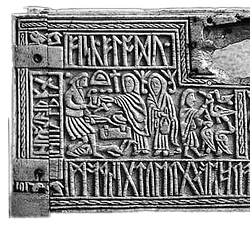 Gary Stanfield
Gary Stanfield
The Stanzas of the Old English Rune Poem
Volume 1 of The OERP Book, Second Edition
2012
Available for free online at
http://runicwisdom.info/rwtoc.htm
This is the best book ever written about the Old English Rune Poem (one of the most important sources of runic meaning available). Gary Stanfield’s academic and spiritual insight, combined with his breadth of knowledge and his empathic vision for lost Heathen culture, combine to produce a landmark text.
This book is some 660 pages long! It discusses many elements beyond the rune poem itself and gives a solid understanding of the Germanic culture within which the Anglo-Saxon runes resided. The discussion of wyrd alone is worth the price of entry, even if you have no interest in runes whatsoever.
But you should! Stanfield’s discussion of the Old English Rune Poem highlights how its meaning is heavily rooted in the cultural order that spawned it. To understand the poem (and hence the runes themselves), we have to understand the social conventions, patterns, and beliefs of its originating culture. Stanfield discusses these with wisdom, and conveys them in a way that will make sense for modern readers. In other words, he makes study of the runes a wonderful door for study of all things Heathen.
The bedrock of this book is Stanfield’s deep mastery of Old English – he provides multiple translations of each stanza of the poem, and goes deeply into points of translation controversy. In doing so, he is able to draw out every last association, wring every last drop of meaning from the words. Nowhere else have I read such rich discussions of the runes.
Stanfield sees the poem as having multiple layers of meaning, and he explores them with depth and humanity. If this book is heavily reconstructionist in orientation, it nevertheless does not sacrifice one drop of spiritual depth or insight. In fact, this book represents the cutting edge in healing the wearisome divide between personal intuition and historical factuality in Heathen practice.
But beware! Stanfield’s research exposes some entrenched but likely baseless assumptions about the runes’ meanings, and things do sometimes get highly technical. There are a few sacred cows slain in the course of the book, and it is best read with a humble and open mind. I can attest, however, that Stanfield’s work has had a profound influence – by far for the better – on my personal understanding of the runes. In stripping away false conceptions about what the lore actually suggests, he offers a great deal of new freedom and understanding.
Is the book perfect? No. Sometimes it seems to contradict itself. For example, are the surface meanings of each poem significant or not? Despite a clearly expressed stance, he nonetheless seems to silently prevaricate on this point. There are other limitations, too. Sometimes the text gets a little terse or high handed. Sometimes his heavy-going discussion does not seem to produce much new understanding. But these are niggling flaws. They only serve to highlight the excellence of the text.
Stanfield argues that the Anglo-Saxon and Norse runic alphabets (the Futhork and Younger Futhark) are different systems, and that there is no need to somehow resolve the divergences in meaning between their respective rune poems. But though his focus is on the Anglo-Saxon runic tradition, much of his insight can be easily adapted to the Norse rune row, as well as to the pan-Germanic Elder Futhark rune alphabet.
This book highlights the truth of an observation made to me recently by an Anglo-Saxon Heathen. Namely that there does not seem to be a thorough-going, deep-working Old Norse Heathen current in contemporary US Heathenry. The Norse sources have not been explored with anything like the penetrating depth that Anglo-Saxon Heathens such as Stanfield have managed with their branch of historical Heathenry.
Indeed, I question if any other branch of modern Heathenry has reached the depth of the Anglo-Saxon specialists (though some of the Pennsylvanians might prove me wrong there). Even if you are not committed to a particular cultural thread of Heathenry, it is hard not to be inspired by the Anglo-Saxons’ efforts.
The Stanzas of the Old English Rune Poem is a monumental achievement. It raises the bar on runic studies among Heathens by a vast margin. I recommend it to anyone who has any interest whatsoever in the pre-Christian traditions of Europe.









[…] Read the full review […]